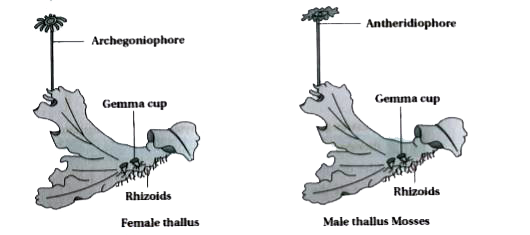Write a note on Liverworts.
Text Solution
• Habitat: The liverworts grow usully in moist, shady habitats such as banks of streams, marshy ground, damp soil, bark of trees and deep in the woods. The plant body of a liverwort is thalloid e.g., Marchantia.
• The leafy members have tiny leaf-like appendages in two rows on the stem-like structures.
• Reproduction : Asexual reproduction in liverworts takes place by fragmentation of thalli or by the formation of specialised structures called gemmae.
• Gemmae develop in small receptacles called gemma cups located on the thalli.
• The sporophyte is differentiated into a foot, seta and capsule.
• The gemmae become detached from the parent body and germinate to form new individuals.
• Sexual reproduction : During sexual reproduction, male and female sex organs are produced either on the same or on different thalli.
• The sporophyte is differentiated into a foot, seta and capsule.
• After meiosis spores are produced within the capsule. These spores germinate to form free-living gametophytes.

|
Topper's Solved these Questions
- PLANT KINGDOMBOOK - KUMAR PRAKASHANCHAPTER - PLANT KINGDOMEXERCISE - SECTION - B (DIFFERENCE/SCIENTIFIC REASONS)
7 Videos
- PLANT KINGDOMBOOK - KUMAR PRAKASHANCHAPTER - PLANT KINGDOMEXERCISE - SECTION - C (DIFFERENCE/EXPLANATION - TERMS/IMPORTANCE/FULL NAME/CONTRIBUTION OF SCIENTISTS)
18 Videos
- PLANT GROWTH AND DEVELOPMENTBOOK - KUMAR PRAKASHANCHAPTER - PLANT GROWTH AND DEVELOPMENTEXERCISE - OBJECTIVE SECTION (FILL IN THE BLANKS)
7 Videos
- RESPIRATION IN PLANTSBOOK - KUMAR PRAKASHANCHAPTER - RESPIRATION IN PLANTSEXERCISE - Questions from Module (Question Paper)
3 Videos
Similar Questions
Knowledge Check
$ Protonema is found in the life cycle of Liverworts.
! Liverworts have multicellular rhizoids.AIf both As and R are correct and R is correct explanation of AsBIf both As and R are correct but R is not correct explanation of AsCIf As is correct, R is wrongDIf both As and R are wrong.Assertion. Rhizoids of liverworts are unicellular.
Reason. Liverworts can not develop multicellular rhizoids.AIf both Assertion and Reason are true and the Reason is a correct explanation of the Assertion.BIf both Assertion and Reason are true but Reason is not a correct explanation of the Assertion.CIf Assertion is true but the Reason is false.DIf both Assertion and Reason are false.
